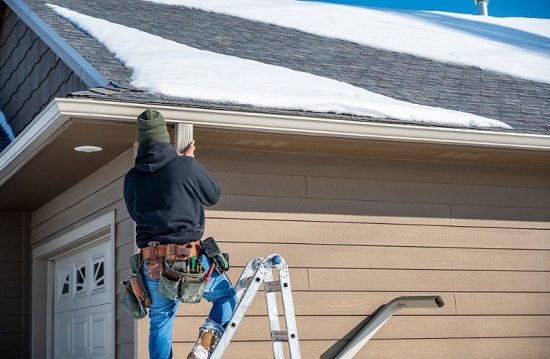In every effective building design, every component plays a vital role in ensuring the functionality and longevity of a structure. Architects and engineers meticulously plan and implement various elements from the foundation to the roofing. However, one often overlooked yet critical aspect of building design is the inclusion of eavestroughs, also known as gutters.
To gain a deeper understanding of how eavestroughs contribute to a structure’s overall functionality and durability, it’s best to visit the website of reputable businesses. Discover their role in rainwater management and their ability to prevent foundation damage, soil erosion, and water infiltration. By efficiently collecting and redirecting rainwater, eavestroughs ensure the building remains structurally sound for the long term.
Eavestroughs serve as a crucial feature that effectively manages rainwater and safeguards the overall integrity of the building. This article will further delve into eavestroughs’ significance in effective building design and how they contribute to the structure’s functionality and durability.
Importance Of Proper Rainwater Management
Water management is a key consideration in building design. Improper rainwater handling can lead to numerous problems, including foundation damage, soil erosion, and water infiltration into the building.
Eavestroughs are crucial in efficiently managing rainwater runoff by collecting it from the roof and directing it away from the foundation as box gutter, fascia integrated gutter, square gutter, half-round gutter, and quad gutter are just some examples. By doing so, they prevent potential water-related issues and maintain the structural integrity of the building.
Here are ways in which they contribute to enhancing the functionality and durability of the structure.
-
Prevent Foundation Damage
One of the primary functions of eavestroughs is to prevent water from pooling around the foundation, which can cause significant damage over time. When rainwater is not effectively directed away from the building, it can seep into the soil surrounding the foundation and lead to erosion and compromising its stability. Resulting in issues such as cracks, shifts, and even structural damage.
It’s essential to know how to install properly sized eavestroughs and ensure they remain free of clogs. The eavestroughs should be designed to handle the expected rainfall volume in the region. It’s best to consider factors such as roof size, slope, and rainfall patterns when determining the size and capacity of the gutter so architects can safeguard the foundation from water-related issues.
-
Protect Exterior Surfaces
Rainwater can be detrimental to the exterior surfaces of a building, including the walls, windows, and doors, which leads to excessive moisture that can cause paint to peel, wood to rot, and metal to corrode. Eavestroughs direct rainwater away from wooden elements—such as window and door frames—and metal components—such as flashing and gutters—that will prolong the lifespan and maintain the strength and durability of the material.
By channeling rainwater away from these surfaces, eavestroughs play a vital role in preserving the aesthetics, durability, and longevity of the building. Additionally, eavestroughs help prevent water stains on the exterior walls, ensuring the building maintains its visual appeal.
-
Prevent Soil Erosion
Eavestroughs play a crucial role in preventing soil erosion around the building. When rainwater is allowed to flow directly off the roof without proper management, it can cause significant erosion of the soil near the foundation, posing risks to both the landscape and building stability.
Eavestroughs, in conjunction with downspouts and properly designed drainage systems, redirect rainwater away from vulnerable areas, preventing soil erosion and its associated risks. Designers of drainage systems consider factors like topography, rainfall patterns, and soil composition in order to preserve the stability and integrity of the building.
-
Preserve The Basement
Ineffective rainwater management can lead to moisture accumulation in the basement, which poses a range of problems, such as mold growth, musty odors, and potential damage to stored items. Moreover, eavestroughs provide moisture infiltration into the basement that can prevent the growth of mildew that can cause respiratory issues and allergies.
Eavestroughs efficiently collect rainwater and divert it away from the building, minimizing the risk of water seepage into the basement, preserving its dryness, and creating a healthier indoor environment. By preserving the basement’s dryness, eavestroughs contribute to a healthier indoor environment and protect the building’s foundation from potential water-related damage.
-
Enhance Longevity
By incorporating eavestroughs into the building design, architects ensure the structure’s longevity and reduce the risk of costly repairs. The prevention of water-related issues, such as foundation damage, rotting, and mold growth, significantly extends the lifespan of the building. Eavestroughs, when properly installed and maintained, provide long-lasting protection against water-related damage and effectively manage rainwater, thereby preserving the overall integrity of the structure for years to come.
Conclusion
Eavestroughs play a crucial role in effective building design by effectively managing rainwater and preventing water-related issues. Incorporating properly sized eavestroughs and ensuring their regular maintenance are key considerations in safeguarding the building’s integrity. By addressing rainwater management from the initial design phase, architects can create durable, aesthetically appealing, and protected structures to prevent signs of repairs. Including eavestroughs is a proactive measure that enhances the longevity of buildings and ensures their functionality for years to come.





























